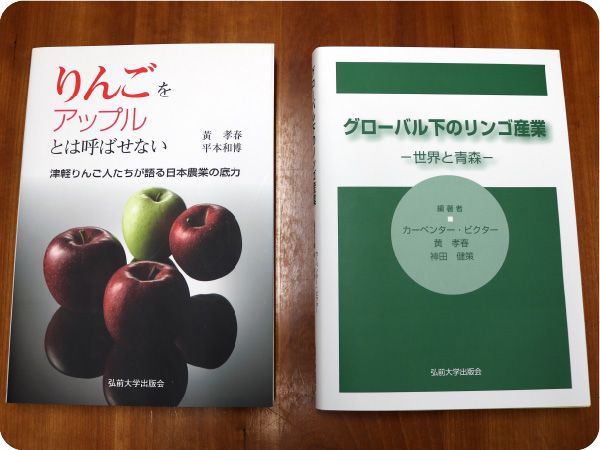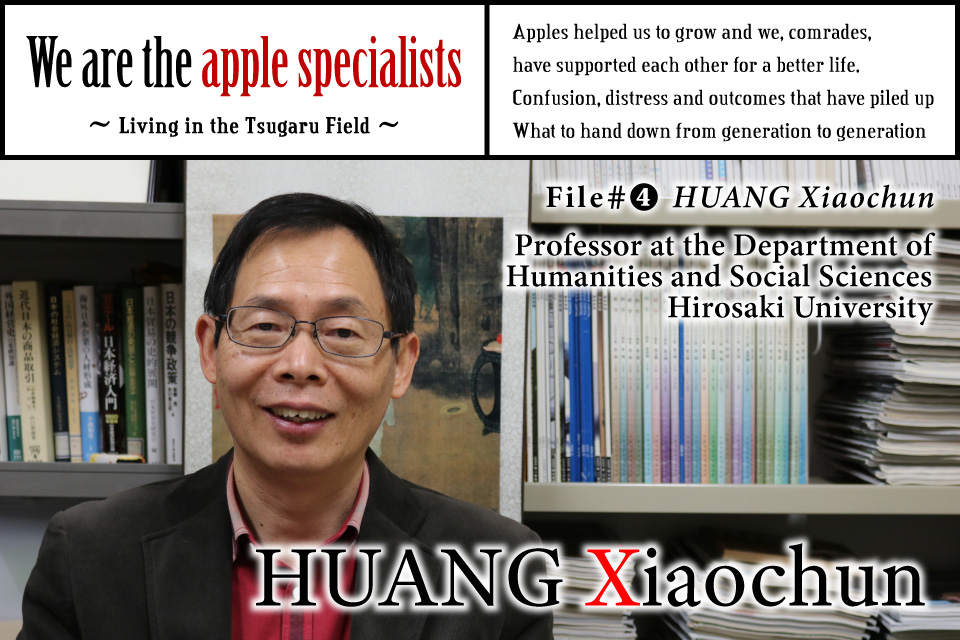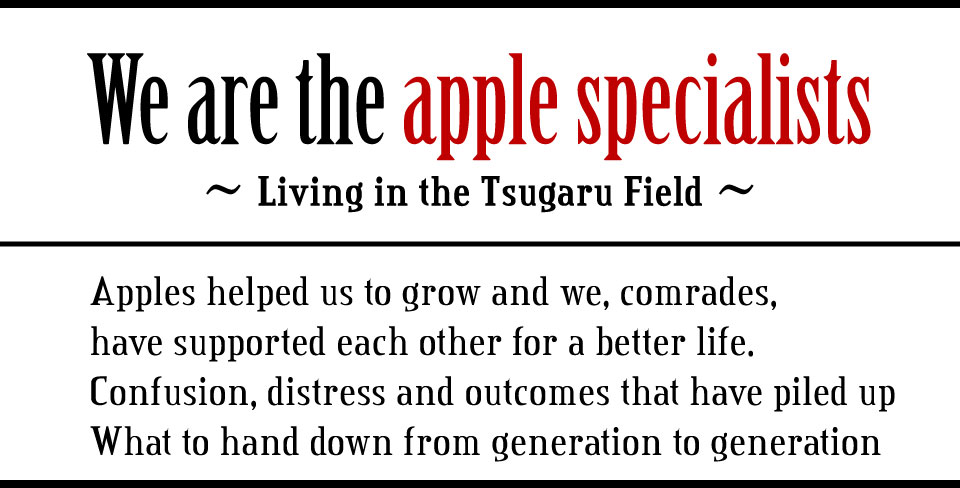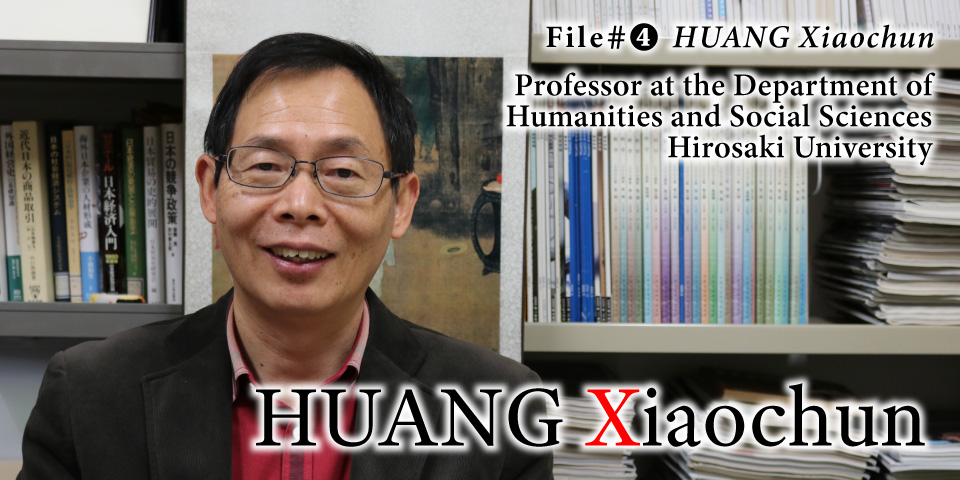There is a man who foresees the future of Aomori apples more than anyone else.
Through destiny, this man crossed the sea to Hirosaki, a foreign land, and became fascinated by apples, eventually becoming essential to the apple industry.
Being chosen by the apples, his mission has not been completed yet.
File#④ HUANG Xiaochun
Huang was born and raised far from Aomori in Hubei Province, the People’s Republic of China, where they don’t grow apples nor sell Aomori apples. Having grown up with no exposure to apples, Huang Xiaochun, 55, now engages with Aomori apples as a professor at the Department of Humanities and Social Sciences, Hirosaki University, Aomori.
On October 7, 1962, he was born in a small town in Hubei Province, PRC. It is located in the south of China, a tangerine-growing district. There were no apple trees. He had never eaten apples nor seen them until he became a college student. He liked the taste of apples, but he was not interested in the fruit then. Still more, he had never imagined that he would study apples in Japan.
Study-abroad
After graduating high school, he entered Wuhan University in Wuhan, the capital of Hubei and the central city. There were many students who wished to study abroad in their first year. He was one of them, and chose France to study. He was interested in the Enlightenment, which led to the beginning of the French Revolution. He hoped to study Philosophy in France. He successfully passed the examination to become an overseas student, sent by the government with all expenses paid for studying abroad. He was just waiting for instructions from the office. He was ready to fly, but he arranged to study French in a foreign language school. He had to wait for a long time while others proceeded steadily in their preparations to study-abroad. As he wondered how things were going, he received a notice stating that his destination had been changed to Japan. He was very surprised. He never thought of going to Japan because he had hoped to study in France in Europe and had taken the test to do so. He asked the person in charge the reason why it had been changed to Japan. “Japan will become an important country in the world. The government wants to send students there,” he answered. Huang was from a poor family in a rural area and he couldn’t afford a privately funded study-abroad program. Although it was against his wishes, his strong mind for study-abroad overwhelmed him and he became interested in Japan, as it seemed to be important. He finally decided to take the chance. At the same time he felt pressure to start studying Japanese straight away.
After the decision, Huang planned to study Japanese at the Dalian University of Foreign Languages (DUFL) in Dalian in northeast China. Before his enrollment at the university, he decided to use the preparation time for voluntary Japanese study. He attended a beginner’s class at school to observe for two months. The instructor then was a woman who later became his wife (referred to as Mrs. Huang). He studied Japanese for half a year at DUFL before he arrived in Japan in October, 1984 and enrolled in Kyoto University. At the same time, Mrs. Huang happened to be studying in Kyoto University under a training program where teachers of Japanese could learn the language and the culture of Japan. Although they were in different positions, a student and a teacher, they were stationed in Kyoto at the same time by accident, not by choice. With an unexpected change of destination, a meeting with Mrs. Huang, and the timing of their visits to Japan, there must have been a bit of fate between the two. The Japan-China Friendship Association in Kyoto played an important role for the couple in supporting their new lives in Japan. There they met a kind couple who took good care of and sponsored the young couple. They even suggested they get married and hold a bridal ceremony after they found out that they were lovers. Everything went smoothly and they were married in less than one year after they arrived in Japan. Mrs. Huang had planned to return to China after a year, but she decided to stay longer with Huang as a married couple, and studied even more. Huang studied the Japanese language as well, and expanded his intense studies into the fields of culture, history and the economic history of Japan. In November 1989, their first son was born and Huang lived a busy but fulfilled student life.
After he earned a doctorate degree in Theoretical Economic and Economic History from Kyoto University, he was supposed to go back to China, having completed his studies in March 1991. This was because he was supported financially by the Chinese government with the condition of acquiring a degree in a certain time period. But there was an issue about whether he should return to China or not, considering the unstable political and economic condition of the country just after the Tiananmen Square incident. Feeling indecisive, Huang consulted his former teacher at graduate school. The teacher was worried about his situation as well. He said, “China is now in an environmentally poor condition to research. I’d advise you to stay in Japan a little longer for better surroundings.” Huang had an idea to build his career in Japan as well. And he thought, “I’ll stay here and work for a few years for the time being, before going back to China.”
To Hirosaki
Having decided to stay in Japan, Huang again consulted his former teacher for a job. He was introduced to three universities for employment opportunities. Among them was Hirosaki University. It was his first encounter with the name of Hirosaki. At the time he erroneously read the kanji as “Hiromae”, and never knew where it was located. “From just the Chinese characters, I thought it might be somewhere in the suburbs of Tokyo, with an old town atmosphere,” he said with a smile. He immediately prepared the required documents and sent out applications to the three organizations that were introduced by the former teacher. Soon he received a phone call from Hirosaki University, one of the three. He found out for the first time then that it is in Aomori Prefecture. He thought it was far away and a cold region, but decided to go for a job interview. He was accepted. His work at Hirosaki University started. This is the story of how he made it to this city. He received correspondence from the other two universities long after his employment at Hirosaki began. In this way it seems like it was Huang’s fate to come to Hirosaki.
In April 1991, Huang arrived in Hirosaki. “I was very surprised to see the scenery full of apple orchards, as far as the eye could see,” he said, and it was his first contact with Aomori apples.
The year he arrived was the year of a devastating incident for the apple industry in Aomori. On September 28, 1991, the huge typhoon No.19 - called the “Ringo Typhoon” later on - landed in the Tsugaru region of Aomori Prefecture. Huang says that he still remembers the scene clearly. “The window glass of my room broke and I saw a big tree knocked down and the bags for apples were thrown into the air. It was incredible. I was so scared.” Just 10 days before the typhoon hit, his wife and son, then living in Kyoto, visited him and they enjoyed cycling through the apple orchards and praised the red fruit on the trees. After the typhoon hit, Huang was so worried about the orchards that he saw while cycling that he went out to see them. He recalled, “I gasped and was speechless when I witnessed that almost all the apples had fallen on the ground. It was shocking.”
The “Ringo Typhoon” was an impressive incident even for Huang, who wasn’t then concerned with apples at all. He was touched by “Ringo no Namida”, a collection of compositions by school children to apple farmers in Hirosaki.
This incident became one of the reasons for him to stay longer in Japan. His plan of a few-years-stay gradually wavered. He started to think this way: “It seemed to be no problem to keep living in Japan, and not to return to China.” So he decided to continue working in Japan. In 1994 he invited his wife and son from Kyoto and started a new family life in Hirosaki. Later they had a daughter and settled down to a new life in the city.
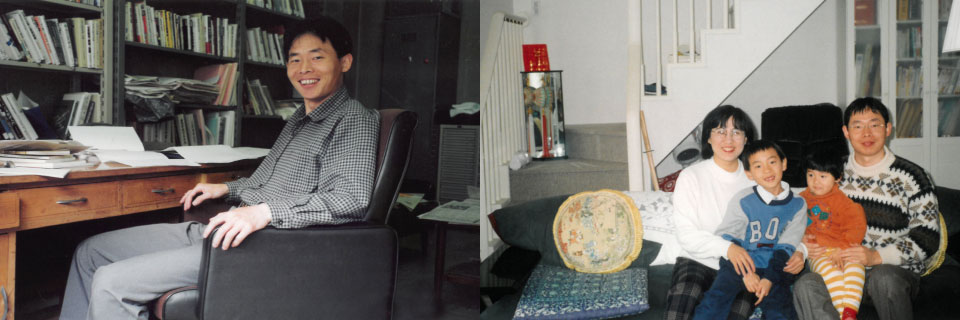
(right)With his family of four
The beginning of the apple industry survey
Apple Aomori Association Incorporated*, presently Public Interest Incorporated Foundation, donated research funds to Hirosaki University in 2001. With the funds, the university started to advertise themes of research campus-wide. Huang then didn’t intend to apply, being unconcerned with anything about apples. But hearing the sound of “apples” reminded him of that incident, the “Ringo Typhoon”. Prof. Kanda of the Dept. of Agricultural and Life Sciences asked, “Would you be interested in applying for a research theme in a group? I’d like to conduct a survey of the apple industry in foreign countries. You may be travelling overseas.” Huang thought it might be a good idea to apply so that he could travel. Among many research applications, a few themes were selected. His research theme, “Apple Industries throughout the World,” was one of them. Huang, for the first time, got involved with the apple industry. The members of the group were the professors of agricultural management and economic policy. Among them were Prof. Kensaku Kanda of Agricultural and Life Sciences who encouraged the application, and Prof. Carpenter on the Faculty of Literature. Both of them became indispensable figures for Huang in subsequent research studies.
*An organization for the purposes of apple industry development, democratization of farming villages and services for producers.The first countries for the survey titled “The Apple Industries throughout the World” were Australia and New Zealand. Huang visited Huon Valley, Tasmania and Hawkes Bay, New Zealand to investigate apple growers, shipping dealers, exporters, processors and research facilities. Huang recalled the scenes and said, “I had no knowledge of the matter then, even though it was called an investigation. I couldn’t quite understand what they explained. But it was interesting to listen to them. There was a topic about a “Club System,” which is now my research theme. I had no idea this “Club System” would become the one.” He also added, “It piqued my curiosity, even though I was mostly there for fun.”
Later Huang visited Michigan, the USA, and Shan Xi Sheng and Shan Don Sheng, China, to examine changes in the international markets, production of the region, marketing, and political strategies of the governments.
After returning to his office at the university to write a report, he realized that the “Club System” sounded very attractive, although he was still just half a tourist, and decided to study about it further, unsatisfied with just a one time report. The first apple industry investigation excited his curiosity and led him to survey club systems all over the world. 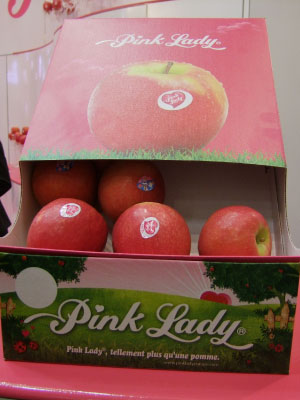
Pink Lady
Further Investigation
The cost for continuous survey and study had to be considered. Huang decided to apply for a Grant-in-Aid for a Scientific Research program operated by the Ministry of Education, Culture, Sports, Science and Technology (MEXT), with the project theme of “The Apple Industry in China.” China is geographically close to Japan, the annual yields of apples were increasing, and it is his home country to start with. It is said that the screening process of the grant is very competitive and it is hard to be selected. But his research project successfully passed the examination and he was granted the funds. Owing to this, Huang and his group members visited China a few times starting in 2007 and built a good relationship with the people of the apple industry in China. In those days, the amount of apple produce in China was 30 times as much as that of Japan. People in the apple industry in Japan, including Huang, had a great interest in China. This project served as basic research on the coexistence between the Japanese and Chinese apple industries. A two-year investigation term was laid out. For the first year they investigated the apple production districts in China, and inspected the situation of apple consumption in both Dalian and Tsingtao in the next. They also conducted a questionnaire survey to learn about the sale of Aomori apples in Tsingtao. They held a symposium to exchange information regarding apple production and consumption in China. In order to understand the issues of the apple industry and comparison of the development of varieties, cultivation, storage, processing, distribution and policy, they tried to interact with people of the industry. At the briefing session upon the completion of the investigative study, Huang met Mr. Mamoru Fukazawa, Manager of Apple Tree Division of Aomori Prefecture in Aomori, who said, “We should export them to many other countries.” And Huang sympathized with Fukazawa’s thoughts.
Soon after, Fukazawa contacted Huang to ask a favor. Aomori Prefecture and an organization of export businesses together established “the Association for the Export Promotion of Agriculture, Forestry, and Fisheries.” He asked Huang to become a chairperson of the association. It is an organization with the purpose of expanding exports of agricultural products. Since Huang had begun to become interested in the exporting business, he was willing to accept the offer. At that time, he was concerned with the apple industry as well as exports. They also began investigating Taiwan, which was the largest market for Aomori apple exports. Professor Carpenter, a long-standing member of the group, applied for another Grant-in-Aid for Scientific Research. Again the project won the honor, after going through the competitive screening. Huang, together with Professors Kanda and Carpenter, was able to proceed with the survey.
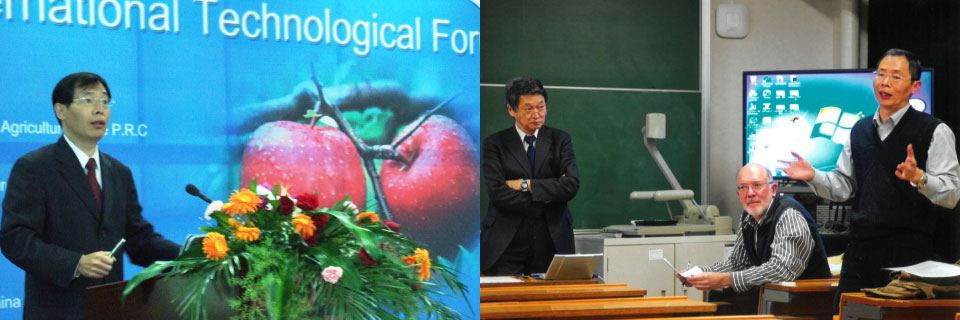
(right)Presentation at 2010 Research Meeting, with Profs. Kanda and Carpenter
In the survey in Taiwan, Huang and other members interviewed each individual major trading company, shipping agents and importers of Taiwan. This aimed to show clearly the process of assimilating Aomori apples into the market as a brand product high in both price and quality. Due to Taiwan’s acceptance as a WTO member in 2001, Japanese apple exports to Taiwan were liberalized, and thus the amount of exports increased rapidly. Up until then, export volumes were limited because of restrictions. So the varieties of apples for export were limited to premium ones used as gifts, such as “Sekai-Ichi” or “Mutsu.” This contributed to the brand image of high quality apples of Aomori. While the effect of ongoing branding continued, the exporters of Aomori expanded the trade volume after Taiwan’s WTO membership. They also included the popular variety of “Fuji” and a larger amount of production, together with the mentioned premium varieties. The group proceeded to extend their market with the cooperation of trading companies and importers. This resulted in a great increase of exports to Taiwan.
The group members, including Huang, played a role in the expansion of wider sales in Taiwan. Huang, with almost no knowledge of apples at the beginning, became a very prominent figure in the apple industry in Aomori.
About the “Club System”
As he became more accustomed with the apple industry, he became more interested in the “Club System” he had heard about in Australia, his first survey country. The “Club System” is meant to control the productivity and distribution of the product using contracts for breeder’s rights and trademark rights, with the cooperation of producers, distributors and saplings growers. A portion of profits from the system is used for marketing and brand protection, so that the system helps to maintain a high product value. Huang found it necessary to adapt the system for the future of the Aomori apple industry. When he told this to Mr. Fukazawa, he was encouraged to do further investigation. He settled down to work seriously on the system and decided to conduct a research survey. For financial aid, he applied for support from the Agricultural Management by General Incorporated Association, of the Aomori Agricultural Management Research Association. He was granted the expense for the survey. He was eager to start it right away, but he didn’t have a clear idea of what to do first.
One day Huang received a phone call from the president of a consulting company in the USA, which was investigating the beer industry in China. He asked to meet Huang because he had read a report on the beer industry in China that Huang had worked on before. Huang met him and they exchanged views. When it came to the investigation Huang was researching, he found out that the company also specialized in agricultural consulting. They ended up with possible partnership. In less than a month after the meeting, the company contacted Huang. They were then investigating Pink Lady, an Australian apple variety, and asked if Huang was interested in participating in the project. Huang thought, “I’d heard that it is a company of agricultural consulting. But I never imagined receiving an offer that fit so perfectly with my project theme. This must have been a gift from heaven.” He was willing to accept the offer and joined without any hesitation. Once he started working with them, the research and investigation went surprisingly smoothly because of the large stock of data gathered by the worldwide network of the company.
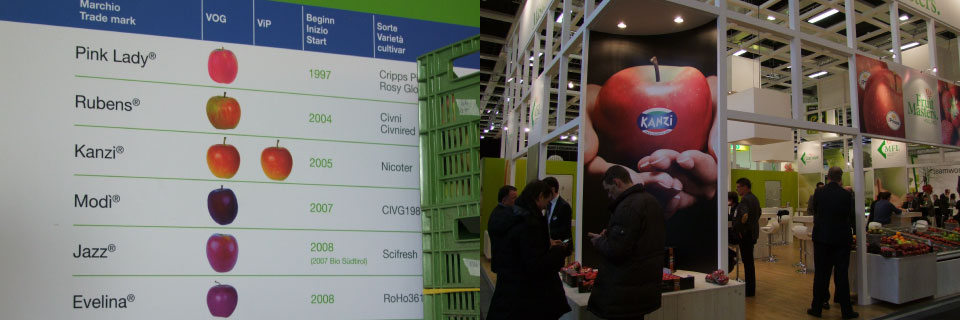
(right)At Kanzi Venue, Fruit Logistica, Messe Berlin 2013
The investigation consisted of: 1) the survey and analysis of the Club System for the “Pink Lady” variety in Australia as an advanced case of branding agricultural and fishery products; 2) the clarification of the controlling mechanism of production and distribution; 3) the study of the actual availability to the Japanese industry. In the “Pink Lady” system, they receive royalties from the breeder’s rights and trademark rights. The royalty benefit is used for the development of new varieties and the protection of breeders, for administrative and promotional expenses, and for the protection of trademark rights as well, aiming to promote and protect the brand. The “Pink Lady” system is a successful case of building a distribution of profits. In order to maintain the high added value permanently, the system helps to secure funds for branding out of the gained profit, and shares the rest of the profits among the breeders and producers. Huang thought it might be a helpful example for the start of branding Japanese agricultural and fishery products. The investigation also made it clear which issues to pay attention to when implementing the system. As a result, the project received a very good reputation from the Ministry of Agriculture and Fishery, which offered another year of funding for further investigation. It was an exceptional treat from the government.
In the second year of the investigation, they focused on the applicability of the system in Japan and examined the reasons why the “Club System” should be considered. They studied various successful cases of club systems and proposed their views on the issues that had been exposed. At that time they considered the introduction of the club system with the “Daikouei” variety. “Daikouei” is one of the six varieties of apples in which an exclusive usage right was set so that only contracted farmers could produce it. The growers and the wholesaler in Hirosaki had settled on the exclusive usage right and the wholesaler agreed to sell seedlings only to the contracted growers. The contracted farmers are then obliged to sell apples through the wholesaler. By doing so, the wholesaler could collect the market fee, the royalty fee for the breeder, the sales promotion fee, and the research development expense. It already sounded like a “Club System,” but no one was concerned about the distribution routes of apples to consumers once “Daikouei” was sold in auction. Although the system made use of breeder’s right, the management failed to consider the trademark rights. When the system started, the concept of the “Club System” was not well known and everything was accepted as it was. If looked at in a different light, it was possible to develop this as a real “Club System” only if the trademark rights were considered. Huang thought it was worthy of trying. Besides, he simply liked eating “Daikouei” and hoped it would become widely recognized in the world.
After the two-year investigation of the “Club System”, he organized the results and held a briefing session in Hirosaki. He meant to hold it privately with limited members, but many people gathered and the hall was packed. Seeing this, Huang knew then that people were interested in the “Club System” and that it would be important, because they had gathered together by word of mouth, without any advertising.
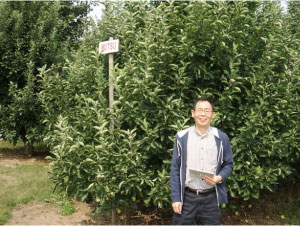
At Kalamazoo, Michigan, USA
Huang and his group members learned that people were very concerned with the system and decided to apply for grants for another two research themes. Both of them passed the screening and they conducted the research. One was titled “Basic Research on the Production and Sale of Agricultural Products under the ‘Club System’”, which Prof. Kanda represented as the principal researcher. In order to study the actual application of the system, they did field studies in countries including Australia, New Zealand, Italy, France, the USA, Chile and China. The group examined countermeasures in anticipation of the next era of variety management. The other project theme was titled “Comprehensive Field Research on the Pink Lady System” with Prof. Carpenter as the principal researcher. In this research, the plans and strategies of each country were studied along with a survey of the actual conditions of the club systems in the world, including Australia.
Through research of actual conditions of the systems in foreign countries, the project group re-confirmed that variety management and problem-solving for the application of the system in Japan were crucial.

(right)At the time of research in 2012 in Angers, France Prof. Carpenter lectured regarding seedlings (taken by Huang)
Present Activities
Huang presently takes part in “Strategy 1: Enterprise”, one of four strategic programs conducted with a university-wide approach. He is now involved in innovation utilizing regional characteristics and resources in the field of Agri-Life-Green and human resource development. With the Agricultural Life Sciences Department at the center, Huang is in charge of planning one of the core projects, “The Possibility of Expanding Exports of Aomori Apples and Possible Problems,” representing the Department of Humanities and Social Sciences. The outline states: “Although Aomori apples are considered to be the major produce of agricultural export, the ratio of exports to the total volume remains only within several percentage points. It is far behind in comparison with that of New Zealand, which has realized the industrialization of agricultural exports. We’d like to find what obstacles remain in shifting the production style of Aomori apples from the domestic market to an export-oriented one. And we will investigate the possible countermeasures to these existing problems. We are going to closely examine every stage: the development of varieties, production, distribution and export. First of all, we will make efforts toward the practical introduction of Good Agricultural Practice (GAP) for the further expansion of exports. Then we aim to provide apple farmers with the know-how learned from the project, and spread the system widely.” Two years of the six year program have passed. Huang thinks that his apple studies will be completed when this project is over. “I had no knowledge of apples when I first arrived in Hirosaki. Even after the investigation started, I was still in tourist mode visiting foreign countries for the apple industry. It could have been a lot easier if I had studied the apple districts in Aomori beforehand. But I never thought of that. Come to think of it, that ignorance made it so much fun to be involved. I could have been less interested in life if not concerned with apples. I’m very satisfied with life now. You never know what will be a turning point in your life,” Huang said.
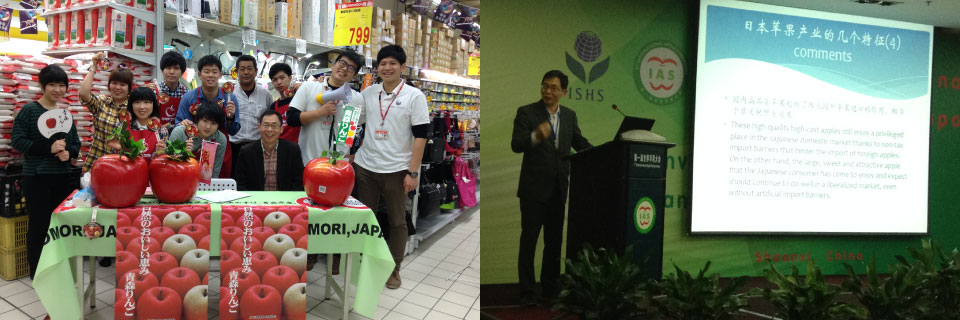
(right)Huang lecturing at the First World Apple Congress in China, October 14, 2016
Examination of Aomori Apples’ Future
There are a big pile of problems regarding the apple industry in Aomori at present. Huang questions how to relate with those problems. He said, “I need to put the research results so far into practice. To begin with, Aomori Prefecture is the major apple production region in Japan. It is very important to maintain its top rank as the chief production district.” It is possible to cope with a lot of big orders from overseas because of high productivity. And the advantages as the main producer enable Aomori to be a stable exporter. An extensive scale of production and yield each year is needed to maintain the status as the No. 1 apple producer. However, at present, issues such as an aging population and a shortage of successors tend to lower productivity, failing to maintain previous levels.
Huang said, “I’d recommend ‘High Density Planting’ to solve the problem.” It is based on a different concept from the conventional one. It enables an early and high income, a uniform production and an improvement of work efficiency. The method aims at the improvement of producers’ income and the reduction of labor. It brings merits such as the ability of aging people to work easier and for newcomers to start cultivation with limited knowledge. Also, “High Density Planting” is the current main technique used in the world. In spite of this, the rate of use is low in Japan. There are many problems, however, and he understands the essential issues from his experience and research in the world, and raises the proper questions in regards to the Japanese industry. He points out, “This method provides an increase in production per acre. We need to keep an eye on “High Density Planting” in order to keep up a certain production level in Aomori, where the farming area is decreasing.” He has a fundamental feeling that Aomori will remain in the No. 1 position as an apple production area.
Another problem-solving method he insists on is the change of view regarding exports. Export volume is normally due to the domestic slump in consumption. Apple exports began in the first place after the domestic market became severe. This idea still persists. But Huang said, “I think we need to produce or perform selective breeding aimed at foreign markets from the beginning, not as an adjustment to the domestic market. We must have a system where we always consider foreign markets, not the idea that we sell overseas because the domestic market sells poorly. It is necessary to improve breeding to compete in the overseas markets. We need to introduce the “Club System” when such a new variety appears. We haven’t been paying attention to breed management so far. But we need to learn and practice these management methods together.” He added, “We must proceed with a system suitable to Aomori and Japan, not just imitate everything from foreign countries.” It is necessary to consider acquiring a GAP certification and registering with the Globally Important Agricultural Heritage Systems (GIAHS) in order to realize his plans. He intends to continue to provide direction and to have a close relationship with the locals, sharing his views as a scholar.
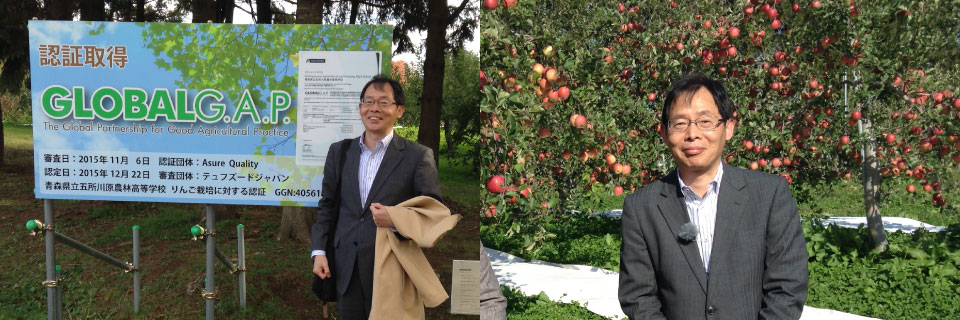
(right)At the filming location of “Sending our apples to the Olympics” by NHK, broadcasted on November 11, 2016
Family and Friends
Huang has enjoyed exercising, such as jogging, since high school, and he now hikes in the mountains as a hobby. He often climbs Mts. Iwaki, Hakkoda and Bonju during day trips and enjoys refreshing himself in nature. Also, he often goes to hot springs. “I have never gone to a hot spring in China. There are surely some in the country. I started going to them in Japan. It’s the best way to refresh,” said Huang.
He has visited foreign countries on research trips, and he is now sorry that he seldom took his family to travel for vacation. “My wife has worked part-time as well and she must have had a hard time with child-rearing. Due to her efforts, I could travel for research while feeling secure. I thank her very much,” he said, impressed. Supported by Mrs. Huang, he has been able to research and study and to support the apple industry in Aomori.
And as for the other group members, Prof. Kanda and Prof. Carpenter have been good friends in both his public and private lives. His whole family has been especially close with Prof. Carpenter’s. “He might have spent more time with me, including research periods, than with his wife,” he said with a smile. At Prof. Carpenter’s retirement party, the number of photos taken showed how closer their relationship was than that of his wife’s. His meeting of these colleagues was blessed as well.
With one incident after another, Huang sometimes wonders why he, with no knowledge of apples, was brought to Hirosaki, Japan and got involved with the apple industry so intensely for such a long time. He found happiness with the fact that he chose to stay in Hirosaki and got acquainted with so many people. He feels fulfilled in his life because of his involvement with apples. “I visited many places for research after I came to Hirosaki. And I have a mission to share the results of my research projects to the people in the apple industry. As scholars, we have no financial or administrative powers. But we can send our message of the importance of exports or the Club System, etc. to the people. I just hope that some messages will remain in their memory. It would be my pleasure if they understand that my research might not be meaningful for a short term vision, but it will be important in the long term,” said Huang, who may be thinking of the future of Aomori apples more than anyone else.
It has been 18 years since he started research on the apple industry. It will never end, and the attempts to put the research results into practice will begin soon for each region in an appropriate manner. Huang will continue to explore the future for the development of Aomori apples.

Written in October 2017 to January 2018.
Published in November 2018
Profile : HUANG Xiaochun
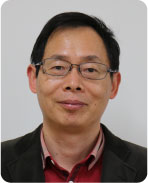
Born in October 1962, in Hubei Province, PRC. Arrived in Japan in October 1984, gained a doctorate degree in Theoretical Economics and Economic History after 6 and a half years. In April 1991, arrived at Hirosaki University as a lecturer. Started research on the apple industries of the world in 2001, the research included more than six major apple production countries and more than five major apple export countries. Became a professor of the Department of Humanities and Social Sciences in 2007. Now involved with projects regarding agriculture and food to practically utilize the research, including an introduction of the Club System to Aomori apples.
His representative books include: A Ringo Cannot Be Called an Apple, Globalization of the Apple Industry – Aomori and the World – (published by Hirosaki University Press)
